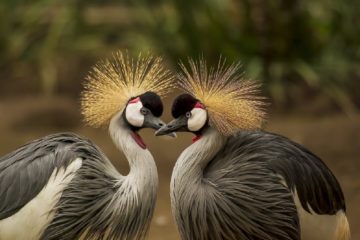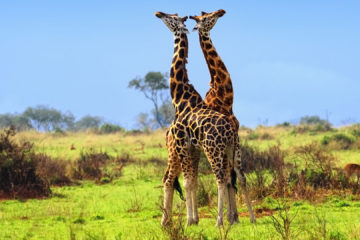Climbing Itinerary
Day 1: Kampala to Kasese Town
Have breakfast and set off for Kasese going through Queen Elizabeth National Park. Make a stopover at Mpambire for traditional drums. You can also stop at the Uganda Equator, a passing point for the imaginary line believed to divide the world into two hemispheres. Then drive through Masaka and get lunch at Mbarara and continue to the Queen Elizabeth National Park one of the biggest parks in Uganda.
Dinner and overnight at Jacana
Day 2: Nyakalengija Trailhead (1600m) – The beginning of Rwenzori Trekking
Shortly after breakfast begin to climb the Nyabitaba hut and later connect to Nyakalengija trail head (1600m). With tour guides and porters hiking up to Nyabitaba hut going through the homesteads and the local plantations which is a wonderful experience. Then follow the trail along the Mubuku River, via the landslides and up and down rocks and bluffs. Cross the Mahoma River and climb steeply through the bracken fern slopes and Podocarpus forest to Nyabitaba Hut for an Overnight.
Day 3: John Matte Hut (3350m)
From Nyabitaba hut, take the trail that drops you down through the forest to the Kurt Shafer Bridge, just below the confluence of the Bujuku and Mubuku Rivers. Ascend via the bamboo forest, traversing a long and exhausting stretch of slippery moss-covered rock. From Nyamileju rock shelter, on clear-sight days, Mount Stanley and Mount Speke can be seen before passing into the zone of the giant heather, lobelia and groundsel. The final stretch to the John Matte hut is across a tiring bog, the first of many for which the mountain is infamous.
Overnight at John Matte Hut (FB)
Day 4: Bujuku Hut (3900m)
After John Matte Hut, the trail goes down to cross River Bujuku and enters Lower Bigo Bog, home of giant lobelias. Jumping a tussock after the other, the bog is crossed but at times the feet taste the freezing ooze. The Upper Bigo bog gives way to Bujuku Lake, with the sight of Mt Baker to the South and Mt Stanley to the West. Bujuku Hut, properly situated in the shadow of Mount Baker and Mount Speke, is in a narrow valley below Stuhlmann Pass. Be ready for this trail which can be very cold for you as well as to the dwellers of Rwenzori.
Overnight at Bujuku Hut (FB)
Day 5: Elena Hut (4541)
Departing from Bujuku, via more bog, the trail climbs the slopes west of the lake, passing through the magical Groundsel Gully as it goes up to Scott-Elliot Pass at 4372m. A metal ladder takes you over a steep section after which the trail splits into two at the head of the gully. The right path goes up to Elena Hut and Mount Stanley on a steep trail over large boulders whereas the left path leads to Scott-Elliot Pass and down to Kitandara Lakes. Overnight at Elena Hut even though the nights may be cold (FB).
Day 6: Margherita Peak (5109m)
Climbing Margherita peak (5109m) to the base of the Stanley Glacier continues. Basing on the weather and one area familiarity, it can be a walk of between 4 to 7 hours to the summit of Margherita. It is a tough walk over three glaciers, slippery rock, ice and very open on many sides. The physically fit are the only ones for this and it is a technical climb which needs roping up, crampons and appropriate equipment for cold, windy and icy conditions. It is good to try the final climb in a group of at least four-two climbers and 2 guides; (the extra guide has to be paid for at the time of booking).
Climb on to the glacier, cross the Stanley Plateau and move on with the ascent. Basing on altitude sickness, fog and weather, scramble up to the summit of Margherita, the Rwenzori peak. It is not guaranteed that everyone will reach the summit because of the altitude and the tough conditions. So do not get disappointed if you do not. Coming back to Scott-Elliot pass, you get spectacular views back to Bujuku Lake and Mount Speke, up to Mount Stanley and down to the Kitandara Lakes. Once over the pass the trail enters an alpine zone of sparse vegetation and rough boulders. Go down to Kitandara Hut for overnight, past the Kitandara Lakes. (If you do not wish to climb the peak, a more restful day walking from Elena Hut to Kitandara Hut 4,023m.) (FB)
Day 7: Guy Yeoman Hut (3260m)
After Kitandara, the trail goes up steeply to the headwall, spreading out from the Mount Baker base and proceeds to the south side of the mountain to Fresh field Pass. On a good day, you see part of the Congo in the west and Mount Stanley in the north. From the pass, the long muddy goes down, going throiugh the rock shelter at Bujongolo, this is the base camp for the historic expedition by the Duke of Abruzzi in 1906 (FB).
Day 8: Nyabitaba Hut (2650m)
This hike will lead via the path down but can be slippery and muddy with little to hold on. Thus, you must be careful balancing over the vertical mud or steep rocks. Overnight at Nyabitaba Hut (FB).
Day 9: Nyakalengija trailhead (1600m)
From Nyabitaba hut, descend gently to the muddy paths to the trailhead. Arriving late morning, head to Kasese for lunch and then drive to Queen Elizabeth National Park. On your drive, look keenly for the wild game which makes this park a superb safari hub. If time allows in the afternoon, enjoy a launch cruise on the Kazinga Channel where mammals and a variety of birds are seen over the lake shores.
Enjoy Dinner and Overnight accommodation at Mweya/Jacana (FB)
Day 10: Queen Elizabeth-Kampala
Start the day with an early morning game drive, then head to the Lodge for breakfast. Check out of the lodge and depart for Kampala, having lunch en route. Arrival in Kampala late afternoon, retiring to your booked accommodation or connecting to the airport for your flight back home.
TOUR GUIDELINES
Access to Rwenzori
From Kampala via Mbarara to Kasese or from Kampala through Fort Portal and then 75km south on the Fort Portal/Kasese by road. The park is 25km from Kasese town. By air: Chartered planes are available from Entebbe/ Kampala to Kasese and then by road to the park.
Accommodation.
Many accommodation facilities in Kasese town. Rwenzori Mountaineering service operates accommodation facilities-huts with bunk beds along the central circuit
Safety and health on the trail
The high altitude and cold wet conditions of Rwenzori Mountains can adversely affect UN experienced visitors or any foreign tourist. The following are ailments, which may occur:
Hypothermia, Dehydration, Altitude sickness, AMS (Acute Mountain Sickness) HAPE (High altitude sickness pulmonary edema) and HACE (High altitude cerebral edema).
Behavioral precautions at the huts and on the trail
– Accept the park’s limit of 15 people per hut per night. Delaying your first departure a day may mean less congestion at huts and much more pleasant trip.
– Don’t litter the park with non-burnable or biodegradable items like tins, plastic and silver foil. Personally collect these things and ensure that you or your porters take them out of the park.
– Kindly use the latrines for all body wastes.
– Respect others in the huts by sharing space, stoves and talking with a low tone
– Observe the prohibition of wood fire. Making fires using local wood is not allowed in the park. You can use your own paraffin stove or gas or charcoal provided and please be considerate to your porters by bringing minimum equipment. Extra personal gear means heavier loads or extra porters, which is bad for the porter but also for the environment.
– Minimise damage on trails by following your guide closely-avoid making new paths. Each time a hiker makes a new route, the paths get wider and more vegetation turns to mad. Or ask your guides on how to conduct yourself.
-Ask your guides anything you do not understand because they are well versed with the area information.




Tour Reviews
There are no reviews yet.
Leave a Review